Tuesday, 28th May 2024
India's Foreign Trade Relations with Key Partners
In News: As per the most recent data from the Ministry of Commerce & Industry, India has reported a trade deficit (the variance between imports and exports) with nine out of its top ten trading partners in the fiscal year (FY) 2023-24.
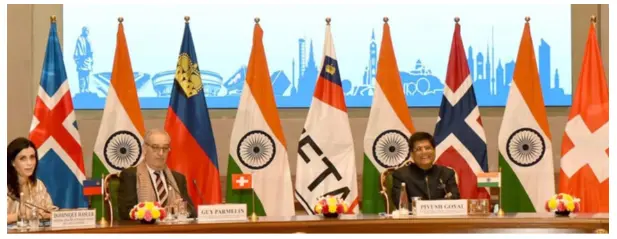
India's Foreign Trade Overview
- Foreign trade in India, encompassing both merchandise and services, accounted for 48.8% of India's GDP in 2018.
- The Ministry of Commerce and Industry administers trade at the Central Government level.
- In 2022, India ranked 15th in total exports and 8th in total imports globally.
- China was India's primary trading partner until recent years, followed by the UAE and subsequently the US.
- According to the Commerce Ministry, India's top exports include Refined Petroleum, Diamonds, Packaged Medicaments, Jewellery, and Rice.
- Major export destinations for India are the United States, United Arab Emirates, Netherlands, China, and Bangladesh.
- India was the world's largest exporter of Diamonds and Rice in 2022.
- India's top imports consist of Crude Petroleum, Coal Briquettes, Gold, Petroleum Gas, and Diamonds.
- Key import sources for India are China, UAE, the US, Saudi Arabia, and Russia.
- In 2022, India was the world's biggest importer of Coal Briquettes, Diamonds, Palm Oil, Mixed Mineral or Chemical Fertilizers, and Nitrogenous Fertilizers.
Latest Trends of India’s Foreign Trade
- China has overtaken the US as India's largest trading partner, with a total two-way commerce of $118.4 billion in FY 2023-24.
- India's exports to China increased by 8.7% to $16.67 billion, while imports rose by 3.24% to $101.7 billion.
- Conversely, exports to the US slightly decreased to $77.5 billion, with imports dropping by about 20% to $40.8 billion.
- The UAE ranked as India's third-largest trading partner with $83.6 billion, followed by Russia, Saudi Arabia, and Singapore.
- India's trade deficit with China, Russia, Korea, and Hong Kong increased in 2023-24 compared to the previous fiscal year.
- However, India maintains a trade surplus with the US and several other countries, with the total trade deficit narrowing to $238.3 billion in FY 2023-24 from $264.9 billion in the previous fiscal year.
Analysis and Recommendations
- Imports can be beneficial for manufacturing and exports, but they may lead to currency depreciation and increased debt.
- To address the trade deficit, measures such as boosting exports, reducing unnecessary imports, developing domestic industries, and managing currency and debt levels effectively are essential.
Source: TOI
Need for a New Export-Import Policy in Indian Agriculture
In News: According to recent data from the Department of Commerce, India witnessed a decrease of 8.2% in agricultural exports during the fiscal year 2023-24, largely attributed to government restrictions on various commodities.
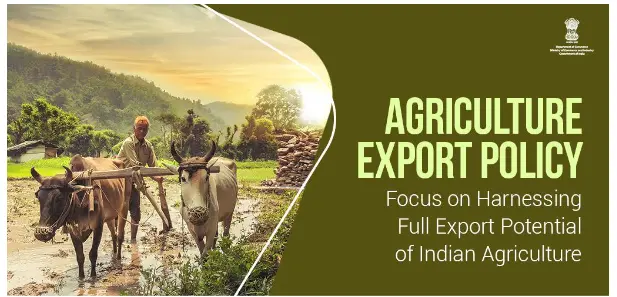
Current Status of Indian Agricultural Exports and Imports
- Agricultural Exports Decline
- India's agricultural exports witnessed a significant decline of 8.2% in the fiscal year 2023-24, amounting to USD 48.82 billion.
- This decline followed a record-breaking performance of USD 53.15 billion in the previous fiscal year 2022-23.
- Impact on Specific Commodities
- Sugar Exports: Export restrictions led to a decrease from USD 5.77 billion in the previous year to USD 2.82 billion in 2023-24.
- Non-Basmati Rice Exports: A ban on white non-basmati rice exports reduced overall exports from USD 6.36 billion to USD 4.57 billion.
- Wheat Exports: Exports dropped from USD 2.12 billion to USD 56.74 million due to halted exports since May 2022.
- Onion Exports: Despite lifting the ban, exports decreased to USD 467.83 million from USD 561.38 million in the previous year.
- Growth in Some Commodities
- Basmati rice and spices exports witnessed growth, reaching USD 5.84 billion and crossing the USD 4 billion mark, respectively.
- Marine products, castor oil, and other cereals also contributed to the overall export basket.
- Agricultural Imports Dip
- India's agricultural imports decreased by 7.9% in 2023-24, mainly attributed to lower global prices of edible oils.
- Reduced Edible Oil Imports
- Lower global prices resulted in a decline in vegetable oil imports from USD 20 billion to below USD 15 billion.
- However, pulse imports nearly doubled, reaching USD 3.75 billion, reflecting continued dependence on foreign sources.
Factors Influencing Agricultural Exports and Imports
- Export Restrictions
- Government-imposed curbs on commodities like rice, wheat, sugar, and onions to manage domestic availability and food inflation.
- Global Price Movements
- Fluctuations in global prices significantly impact India's agricultural trade, with recent spikes followed by a decline influencing export and import volumes.
- Government Policies
- Policy measures such as reduced import duties on pulses and edible oils contradict efforts to boost domestic production, affecting long-term agricultural development.
Agricultural Export Policy
- Objectives and Implementation
- India's Agricultural Export Policy, launched in 2018, aims to double agricultural exports by 2022 and promote various agricultural products globally.
- Strategic and Operational Elements
- The policy focuses on strategic measures like infrastructure development and operational aspects like value-added exports and marketing strategies.
Challenges and Recommendations
- Policy Instability
- Frequent changes in export policies disrupt market stability and trade relationships, necessitating more predictable and rules-based policies.
- Conflicting Goals
- Balancing consumer affordability with promoting domestic production requires careful policy planning to avoid undermining agricultural self-sufficiency.
- Subsidy Centric Schemes
- Populist measures during elections can strain fiscal resources and hinder agricultural sector growth, highlighting the need for sustainable policies.
- Inadequate R&D Investment
- Increased investment in agricultural research and development is essential to enhance productivity and competitiveness in global markets.
- Quality and Standards
- Ensuring compliance with international standards is crucial for sustaining export growth and market access for Indian agricultural products.
Steps Ahead for Stable Agri-Export Policy
- Balancing Interests
- Policies should balance short-term interests with long-term agricultural development goals to ensure stability and sustainability.
- Strategic Interventions
- Buffer stocks and market interventions can mitigate price volatility, providing stability to farmers and traders.
- Supporting Farmers
- Policies should prioritize farmers' welfare and ensure fair prices for their produce, aligning export benefits with farming communities.
- Infrastructure Development
- Investments in modern infrastructure can reduce post-harvest losses and enhance export competitiveness in global markets.
- International Collaboration
- Diplomatic efforts and learning from successful export policies of other countries can enhance India's global agricultural trade presence.
- Promoting Best Practices
- Emulating successful strategies from countries like the Netherlands and the United States can guide India towards a more stable and prosperous agricultural export sector.
|
UPSC Previous Year Questions Prelims Q. With reference to the circumstances in Indian agriculture, the concept of “Conservation Agriculture” assumes significance. Which of the following fall under the Conservation Agriculture? (2018) 1. Avoiding the monoculture practices 2. Adopting minimum tillage. 3. Avoiding the cultivation of plantation crops 4. Using crop residues to cover soil surface 5. Adopting spatial and temporal crop sequencing/crop rotations Select the correct answer using the code given below: (a) 1, 3 and 4 (b) 2, 3, 4 and 5 (c) 2, 4 and 5 (d) 1, 2, 3 and 5 Ans: (c) Mains (2021) Q. What are the present challenges before crop diversification? How do emerging technologies provide an opportunity for crop diversification? Mains (2020) Q. What are the main constraints in transport and marketing of agricultural produce in India? |
Source: IE
India's Strategic Mineral Procurement Strategy in Africa
In News: India is intensifying its efforts to acquire critical minerals in Africa, aiming to rival China's dominant position in the region.
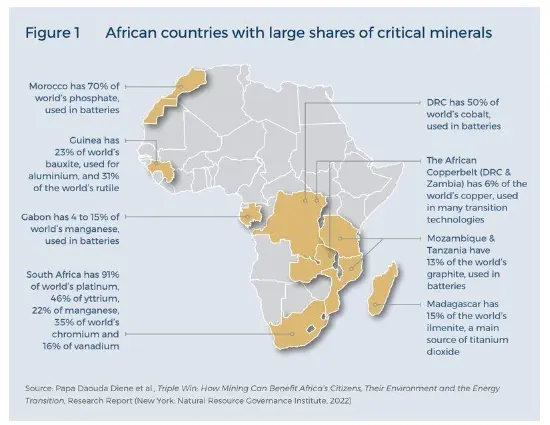
India's Motivation for Acquiring Critical Minerals in Africa
- Resource Securitisation
- India aims to ensure a stable supply of critical minerals for domestic industries, particularly in the electric vehicle (EV) and renewable energy sectors, to reduce dependence on imports and mitigate potential supply chain disruptions.
- This initiative supports India's push towards self-reliance and strategic autonomy in crucial sectors.
- Countering China's Dominance
- India seeks to establish a stronger presence in the African mining sector to counterbalance China's influence, particularly in controlling cobalt processing facilities and lithium resources.
- Access to High-Quality Reserves
- Africa holds significant reserves of critical minerals, presenting an opportunity for India to acquire access to high-quality and economically viable mineral deposits to meet its growing demand.
- Strengthening Bilateral Ties
- India is leveraging government-to-government (G2G) negotiations to secure mining collaborations and access agreements with African nations, aiming to build stronger diplomatic and economic ties with countries in the region.
Other Overseas Critical Mineral Acquisition Plans by India
- Khanij Bidesh India Ltd (KABIL)
- A joint venture of National Aluminium Company Ltd (NALCO), Hindustan Copper Ltd (HCL), and Mineral Exploration and Consultancy Ltd (MECL), KABIL focuses on sourcing and processing strategic minerals from foreign sources, especially battery minerals.
- Coal India Limited (CIL)
- CIL is targeting the acquisition of lithium, cobalt, and nickel assets abroad to diversify its operations beyond coal.
- Minerals Security Partnership (MSP)
- India joined the MSP to aid Indian public sector undertakings (PSUs) in acquiring critical mineral assets abroad and building reliable supply chains through collaboration between governments and industry.
- Supply Chain Resilience Initiative (SCRI)
- Collaboration with Australia and Japan aimed at ensuring supply chain resilience for critical minerals, including the Critical Minerals Investment Partnership with Australia.
- Global Collaborations
- India is collaborating with countries like Chile, Argentina, and Bolivia for lithium resources and in talks with Sri Lanka for a graphite mine block, crucial for battery manufacturing.
Initiatives Prompting India's Secure Critical Minerals
- Panchamrit Vision
- India's commitment to climate change mitigation includes growing non-fossil fuel energy capacity and achieving Net Zero emissions by 2070.
- Strategic Initiatives
- Various government initiatives, including planning commissions, expert committees, and amendments to mining laws, focus on sourcing strategic mineral resources and strengthening exploration and extraction efforts.
|
UPSC Previous Year Questions Prelims (2012) Q. Recently, there has been a concern over the short supply of a group of elements called rare earth metals. Why?
Which of the statements given above is/are correct? (a) 1 only Ans: (c) Mains (2021) Q. Despite India being one of the countries of Gondwanaland, its mining industry contributes much less to its Gross Domestic Product (GDP) in percentage. Discuss. Mains (2017) Q. “In spite of adverse environmental impact, coal mining is still inevitable for development”. Discuss. |
Source: BL
Microplastics
In News: A recent study uncovered the extensive presence of microplastics in the testicles of both humans and dogs, potentially linked to a decline in sperm count. Polyethylene emerged as the most prevalent microplastic, followed by PVC.

Understanding Microplastics
- Definition and Classification
- Microplastics refer to plastic particles smaller than five millimeters in diameter, posing threats to oceans and aquatic life.
- These are categorized into primary microplastics, originating from commercial use and textile fibers, and secondary microplastics, formed from larger plastic breakdown due to environmental factors.
- Applications and Developments
- Microplastics find applications in medical, industrial, and cosmetic sectors due to their effective chemical properties.
- Recent studies reveal alarming levels of microplastics in testicular tissues of both humans and dogs, raising concerns about reproductive health.
- Global Plastic Overshoot Day, projected for September 5th, 2024, highlights the exceeding capacity to manage plastic waste.
Environmental and Health Challenges
- Microplastics persist in the environment, threatening wildlife through ingestion and bioaccumulation of toxic chemicals.
- Humans face health risks from exposure to microplastics, including oxidative stress, DNA damage, and metabolic disorders.
Regulatory and Detection Challenges
- Inconsistent regulations globally hinder mitigation efforts against microplastic pollution.
- Detecting and quantifying microplastics pose challenges due to their diverse properties.
Proposed Solutions
- Promoting biodegradable plastics and enhancing wastewater filtration systems can mitigate microplastic pollution.
- Regulatory measures like bans on single-use plastics and Extended Producer Responsibility (EPR) schemes can reduce plastic waste.
- Innovative alternatives like biodegradable silk, plant-based filters, and natural fiber textiles offer sustainable solutions.
Public Awareness and Education
- Incorporating microplastics education into school curricula can foster awareness and promote sustainable practices.
|
UPSC Previous Year Questions Mains (2019) Q. How can the mountain ecosystem be restored from the negative impact of development initiatives and tourism? Mains (2018) Q. What are the impediments in disposing the huge quantities of discarded solid waste which are continuously being generated? How do we remove safely the toxic wastes that have been accumulating in our habitable environment? |
Source: DTE
Stellaria mcclintockiae
In News: A newly discovered plant species, named Stellaria mcclintockiae, was recently identified on the steep, muddy slopes of the Nelliyampathy hills in Kerala's Palakkad district.
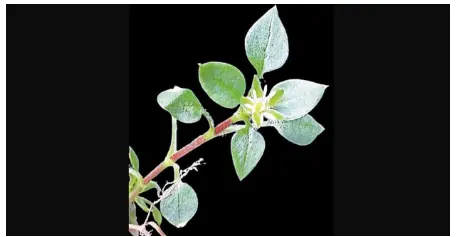
Discovery and Characteristics of Stellaria mcclintockiae
- Stellaria mcclintockiae is a newly discovered species within the genus Stellaria, belonging to the family Caryophyllaceae.
- It is characterized as an annual herb, reaching heights of up to 15 cm.
- Currently, it is exclusively known to inhabit the Nelliyampathy hills, specifically at elevations ranging from 1,250 to 1,400 meters.
- Distinguishing features of this species include unique traits in its petals, pollen morphology, bracts, sepals, and seed architecture.
- Notably, this marks the first reported species of the Stellaria genus found in south India.
- Based on its rarity and limited habitat, researchers have proposed that Stellaria mcclintockiae should be categorized as critically endangered according to the International Union for Conservation of Nature (IUCN) criteria.
Source: TH
Nyishi Tribe
In News: Mountaineer and cricketer Kabak Yano recently made history by becoming the fifth woman from Arunachal Pradesh and the first woman from the Nyishi tribe to successfully scale Mt. Everest.
Overview of the Nyishi Tribe
- The Nyishi tribe constitutes the largest ethnic group in Arunachal Pradesh, India.
- In their traditional language Nishi, "Nyi" refers to "a man" and "shi" denotes "a being", collectively signifying a civilized human being.
- Although the Nyishi language belongs to the Sino-Tibetan family, its origin remains disputed.
- Geographically, the Nyishi people are primarily concentrated in eight districts of Arunachal Pradesh, along with presence in Sonitpur and the North Lakhimpur district of Assam.
- With a population of approximately 300,000, they are the most populous tribe in Arunachal Pradesh.
- The Nyishi tribe sustains itself through slash-and-burn agriculture, hunting, and fishing, supplemented by expertise in handicrafts such as weaving, cane and bamboo works, pottery, blacksmithing, wood carving, and carpentry.
- Religious practices among the Nyishi people vary, with a significant portion adhering to Christianity, Hinduism, and indigenous Donyi Polo beliefs, where the Sun and Moon are revered.
- Major festivals observed by the Nyishi include Boori-Boot (February), Nyokum (February), and Longte (April), focusing on ensuring good harvests, health, wealth, and prosperity.
- Polygyny is prevalent within the Nyishi community, and descent is traced patrilineally, with the tribe organized into several clans.
- Nyishi society lacks a caste system and class stratification, with only loose social distinctions, emphasizing the importance of women as the source of peace, progress, and prosperity. They uphold the significance of women through a reciprocal marital exchange system.
Source: TOI
Zero Debris Charter Initiative
In News: Recently, twelve nations officially endorsed the Zero Debris Charter during the ESA/EU Space Council, reaffirming their dedication to ensuring the enduring sustainability of human endeavors in Earth's orbit.

Overview of the Zero Debris Charter Initiative
- The Zero Debris Charter, launched by the European Space Agency (ESA) at the ESA Space Summit in Seville meeting in November 2023, represents a significant initiative.
- ESA Member States prompted the Agency to adopt a "Zero Debris approach" for its missions and to encourage partners and stakeholders to follow suit.
- This initiative, the first of its kind, brings together a diverse range of space actors globally, united in the common objective of achieving zero debris creation by 2030, thereby ensuring the long-term sustainability of space activities.
- The charter aims to establish comprehensive guiding principles and realistic yet ambitious technical targets to form the basis of a robust Zero Debris roadmap, driving efforts for global space debris mitigation and remediation.
- Although the charter is not legally binding, it fosters a collaborative community of proactive stakeholders committed to collectively defined objectives for the year 2030.
- Key targets outlined in the charter include ensuring that a mission's probability of generating space debris remains below 1 in 1,000 per object and achieving a 99% success rate for post-mission disposal, even resorting to external means when necessary.
- The initiative also emphasizes the importance of transparent information sharing and coordination of space traffic.
- To realize the objectives of the Charter, ESA will focus on developing groundbreaking technologies for satellite end-of-life disposal, in-orbit servicing, and active debris removal.
- Furthermore, ESA will collaborate closely with regulatory institutions responsible for overseeing regulatory aspects related to space activities.
Source: PO
Mundra Port
In News: Mundra Port, the flagship facility of Adani Ports and Special Economic Zone, recently celebrated its 25th anniversary, marking a quarter-century of operational excellence.
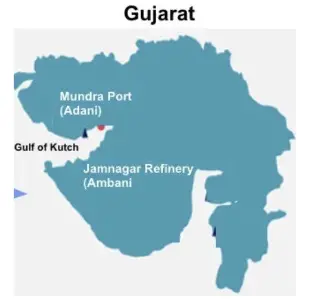
Mundra Port Overview
- Mundra Port holds the distinction of being India's largest private and container port, situated on the northern shores of the Gulf of Kutch, near Mundra, Kutch district, Gujarat.
- It operates as a deep-draft, all-weather port and functions as a special economic zone (SEZ). Approximately 33% of India's container traffic traverses through this port.
Ownership and Handling Capacity
- Operated by Adani Ports and Special Economic Zone Limited (APSEZ), India’s largest commercial ports operator, Mundra Port boasts a handling capacity of 260 million metric tons (MMT).
- In the fiscal year 2022-23, it managed over 155 MMT of cargo, constituting nearly 11% of India’s maritime cargo movement.
- Equipped with 26 berths and two single-point moorings, the port accommodates diverse vessels and manages various cargo types, including containers, dry bulk, break bulk, liquid cargo, and automobiles.
- Notably, it hosts the nation's largest coal import terminal, ensuring swift cargo evacuation with minimal turnaround time.
- The port's rail connectivity to the national rail network enables efficient cargo handling across India.
About MSC Anna
- MSC Anna stands as the largest container ship ever to dock at an Indian port.
- This colossal vessel measures approximately 399.98 meters in length, equivalent to the span of four football fields.
- With a capacity to carry 19,200 TEUs (20-foot equivalent units), MSC Anna is one of the world's largest container ships.
- Notably, its arrival draft of 16.3 meters necessitates berthing at Adani Ports, Mundra, as it is the only port in India equipped to accommodate such deep-draft vessels.
Source: TOI
AI Anchors
In News: DD Kisan Channel Introduces AI Anchors for Innovative Presentation
Introduction to AI Anchors on DD Kisan Channel
Recently introduced on DD Kisan Channel, the AI anchors, named 'AI Krish' and 'AI Bhoomi', possess the capability to communicate in 50 Indian and foreign languages, providing a novel approach to news delivery.
Features of AI Anchors
- Resembling humans in functionality, these AI anchors have the ability to tirelessly present news 24/7, 365 days a year, without experiencing fatigue.
- These AI anchors are set to cater to farmer viewers across all states of the country, ensuring widespread accessibility.
- Serving as an invaluable source of information, the AI anchors will deliver updates on agricultural research, market trends, weather changes, and government schemes, both at the national and global levels.
Overview of DD Kisan Channel
- Established by the Government of India on May 26, 2015, DD Kisan Channel stands as the sole television network dedicated solely to farmers.
Objectives of DD Kisan Channel
- To keep farmers informed about weather fluctuations, global and local market shifts, enabling them to make timely and informed decisions.
- To showcase the endeavors of progressive farmers, fostering agricultural and rural development by disseminating knowledge.
- To promote a comprehensive approach to agriculture, encompassing balanced farming, animal husbandry, and plantation techniques.
Source: TH
Electric Tiller for Small-Scale Farmers
In News: CSIR and DSIR Unveil CSIR-Central Mechanical Engineering Research Institute's Electric Tiller to Empower Small and Marginal Farmers
Innovative Electric Tiller for Small-Scale Farmers
- The electric tiller is specifically engineered to meet the requirements of small to marginal farmers, constituting over 80% of India's farming population with land holdings of less than 2 hectares.
- Featuring enhanced torque and field efficiency, the tiller stands out as a highly capable and effective agricultural implement.
- It emphasizes user comfort and environmental sustainability, incorporating features such as reduced hand-arm vibration, quiet operation, and zero exhaust emissions.
- With the potential to slash operational costs by up to 85%, the electric tiller offers substantial financial advantages to farmers.
- Its user-friendly design facilitates battery pack swapping and supports multiple charging options, including alternating current (AC) and direct current (DC) charging from solar sources, ensuring adaptability and convenience.
- CSIR, established in September 1942 and headquartered in New Delhi, receives funding from the Ministry of Science and Technology.
Source: PIB
Antarctic Treaty Consultative Meeting
In News: A recent article discusses the 46th Antarctic Treaty Consultative Meeting held in Kochi, during which delegates emphasized the need to regulate the increasing tourism in Antarctica to safeguard its environment and tackle territorial issues.
Significance of Exploring Antarctica for India
- Advancing India's Space Program
- Antarctica's unique location and conditions provide an ideal environment for testing India's space technologies, including landers, rockets, and remote sensing systems.
- Conducting experiments in this harsh environment could aid in refining India's space technologies for future missions.
- Securing Energy and Mineral Resources
- Given India's status as the third-largest consumer of energy globally and its need for critical minerals, exploring Antarctica's potential for responsible and sustainable resource extraction could help address the country's long-term energy and mineral security needs, within the regulations of the Antarctic Treaty System.
- Advancing Climate Change Research and Adaptation
- India's geographical vulnerability to climate change makes it crucial to understand Antarctic climate systems.
- Exploring Antarctica could provide valuable insights into climate change impacts, aiding in the development of adaptation strategies.
- Strengthening India's Maritime Capabilities
- Involvement in Antarctic logistics and operations presents opportunities for India to enhance its maritime capabilities, including navigation in icy waters, ship-building for polar environments, and developing advanced icebreaker vessels.
- This would bolster India's strategic interests in the Indian Ocean region and beyond.
- Exploring Bioprospecting Opportunities
- Antarctica's unique ecosystems offer potential for discovering novel microorganisms, enzymes, and bioactive compounds with applications in pharmaceuticals, biotechnology, and agriculture.
- Indian researchers could explore bioprospecting opportunities, contributing to the country's bioeconomy.
Ways India Can Enhance its Role and Contributions in Antarctica
- Developing Advanced Autonomous Systems for Polar Exploration
- India could lead in developing advanced autonomous systems like UAVs and AUVs tailored for polar exploration, enhancing scientific diplomacy through collaboration with other nations.
- Collaborating on Rare Earth Element (REE) Exploration
- India could collaborate with other countries to conduct geological surveys and assessments of potential REE deposits in Antarctica, positioning itself as a key player in responsible and sustainable REE exploration efforts.
- Investing in Sustainable Infrastructure Development
- India could invest in sustainable infrastructure in Antarctica, including renewable energy systems, waste management facilities, and eco-friendly transportation solutions, demonstrating its commitment to minimizing environmental impacts in the region.
- Promoting Responsible and Sustainable Antarctic Tourism
- Collaboration with international partners to develop guidelines and best practices for responsible tourism in Antarctica could help minimize environmental impacts.
- Training Indian tour operators and guides to adhere to regulations and offer educational experiences would raise awareness about the region's unique ecosystems and conservation importance.
|
UPSC Previous Year Questions Mains (2021) Q. How do the melting of the Arctic ice and glaciers of the Antarctic differently affect the weather patterns and human activities on the Earth? Explain. Mains (2018) Q. Why is India taking keen interest in resources of Arctic region? |
Source: TH
Share the article
Edukemy’s Current Affairs Quiz is published with multiple choice questions for UPSC exams
MCQ
Get Latest Updates on Offers, Event dates, and free Mentorship sessions.

Get in touch with our Expert Academic Counsellors 👋
FAQs
UPSC Daily Current Affairs focuses on learning current events on a daily basis. An aspirant needs to study regular and updated information about current events, news, and relevant topics that are important for UPSC aspirants. It covers national and international affairs, government policies, socio-economic issues, science and technology advancements, and more.
UPSC Daily Current Affairs provides aspirants with a concise and comprehensive overview of the latest happenings and developments across various fields. It helps aspirants stay updated with current affairs and provides them with valuable insights and analysis, which are essential for answering questions in the UPSC examinations. It enhances their knowledge, analytical skills, and ability to connect current affairs with the UPSC syllabus.
UPSC Daily Current Affairs covers a wide range of topics, including politics, economics, science and technology, environment, social issues, governance, international relations, and more. It offers news summaries, in-depth analyses, editorials, opinion pieces, and relevant study materials. It also provides practice questions and quizzes to help aspirants test their understanding of current affairs.
Edukemy's UPSC Daily Current Affairs can be accessed through:
- UPSC Daily Current Affairs can be accessed through Current Affairs tab at the top of the Main Page of Edukemy.
- Edukemy Mobile app: The Daily Current Affairs can also be access through Edukemy Mobile App.
- Social media: Follow Edukemy’s official social media accounts or pages that provide UPSC Daily Current Affairs updates, including Facebook, Twitter, or Telegram channels.





